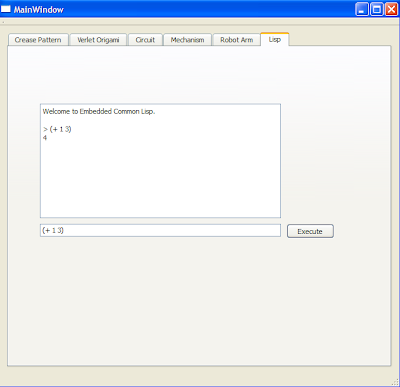Download: QtEclSmallSimulations2.zip (Win32 binary)
I've been working on a few things these past few months. This includes:
I've been working on a few things these past few months. This includes:
- A crease pattern generator that can calculate the crease pattern a piece of paper will have based on the sequence of folds applied to it. Conceptualising the paper as a mesh of facets, and determining the operations that can be performed on facets such as splitting was the key to implementing this.
- A circuit simulator that uses an iterative process to solve the circuit. Since Verlet physics is very successful at applying physical constraints (such as ensuring a point mass is fixed in space, or ensuring two point masses are always a fixed distance apart) using little more than repeatedly pushing objects according to the pressure that each constraint is applying, I thought I would try the same idea with electric circuits and the pressures of KVL and KCL.
When I managed to embed a Lisp interpreter into my app using ECL, I decided this is a suitable thing to tell other people about.
The advantages of scripting using Lisp in this way are numerous and exciting:
- Its an excellent way to ease into the beauty of Lisp without abandoning my other work.
- Initially, I can create Lisp bindings that manipulate the interface of the simulation such as adding components to the circuit, or applying specific folds. Doing this, I get loading/saving functionality for free, because my circuit/origami folds/other simulation configuration are defined in a lisp script. Also, I can manipulate my simulation “live” in the lisp repl while the simulation is running.
- Gradually, I can transfer more and more of the simulation implementation to lisp. Doing so, I can enjoy a real “live coding” environment. I have fluxus to thank for the inspiration.
- Lisp is a magnificent programming language. Having a Lisp repl in my app means I get a beautiful customisable programming language allowing me to describe a DSL without having to write a single line of parsing code.
The possibilities having a Lisp running in your app are breathtaking. In the past, the only thing that kept me from writing my own language to control my simulations was the mind numbing drudgery of writing parsers. Now, I get all the advantages of a custom language completely for free!
The “Lisp” tab is initially active. It features the Lisp REPL. The only C++ function it is hooked to is myadd – not very exciting from the user's point of view, but VERY exciting for me, since it shows that I can have lisp control the whole show!
Non lisp stuff (will be lispified later):
- In the “Crease Pattern” tab, press “Push button” repeatedly to see the effect of applying a fold sequence.
- In the “Circuit” tab, right click a component to select it, and drag the slider to change its parameter (voltage for voltage sources, current for current sources, resistance for resistors.). In between frames, the algorithm runs 100 passes to solve the circuit. You'll notice that the visualisation is inspired by Paul Falstad's circuit simulator – I just wanted to add more interactivity!



No comments:
Post a Comment
Note: Only a member of this blog may post a comment.